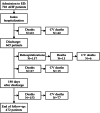In-hospital and long-term mortality for acute heart failure: analysis at the time of admission to the emergency department
- PMID: 32588981
- PMCID: PMC7524058
- DOI: 10.1002/ehf2.12847
In-hospital and long-term mortality for acute heart failure: analysis at the time of admission to the emergency department
Abstract
Aims: Acute heart failure (AHF) leads to a drastic increase in mortality and rehospitalization. The aim of the study was to identify prognostic variables in a real-life population of AHF patients admitted to the emergency department with acute shortness of breath.
Methods and results: We evaluated potential predictors of mortality in 728 consecutive patients admitted to the emergency department with AHF. Possible predictors of all-cause and cardiovascular (CV) mortality were investigated by Cox and Fine and Gray models at multivariable analysis. Among the 728 patients, 256 died during the entire follow-up, 142 of these due to CV cause. The 1 year mortality rate was 20%, with the highest risk of death during the index hospitalization (with 8% estimate in-hospital mortality at 30 days). A higher risk of events during the index hospitalization was more evident for the CV deaths, for which we found a cumulative 1 year incidence of 12% with a cumulative incidence in the first 30 days of hospitalization of about 5%. At multivariable analysis, age (P < 0.001), New York Heart Association (NYHA) class IV vs. I-II-III (P = 0.001), systolic blood pressure (P < 0.001), non-cardiac co-morbidities (≥3 vs. 0, P = 0.05), oxygen saturation (P = 0.03), serum creatinine (P < 0.001), and left ventricular ejection fraction (LVEF) (40-49% vs. <40%, P = 0.004; ≥50% vs. <40%, P = 0.003) were independent predictors of all-cause mortality during the entire follow-up. Age (P = 0.03), systolic blood pressure (P = 0.01), oxygen saturation (P = 0.03), serum creatinine (P = 0.02), and LVEF (40-49% vs. <40%, P = 0.03; ≥50% vs. <40%, P = 0.004) were independent predictors of CV mortality during the entire follow-up. NYHA class IV vs. I-II-III (P < 0.001), serum creatinine (P = 0.01), and LVEF (40-49% vs. <40%, P = 0.02; ≥50% vs. <40%, P < 0.001) remained independent predictors for in-hospital death, while only serum creatinine (P = 0.04), LVEF (40-49% vs. <40%: 0.32, P = 0.04; ≥50% vs. <40%, P < 0.001), and NYHA class vs. I-II-III (P = 0.02) remained predictors for in-hospital CV mortality.
Conclusions: In this real-life cohort of patients with AHF, the results showed a similar mortality rate comparing with other analysis and with the most important registries. Age, NYHA class IV, systolic blood pressure, creatinine levels, sodium levels, and ejection fraction were independent predictors of 1 year mortality, while LVEF <40% was the only predictor of both all-cause mortality and CV mortality.
Keywords: Acute heart failure; Creatinine; Ejection fraction; Mortality predictors; NYHA class.
© 2020 The Authors. ESC Heart Failure published by John Wiley & Sons Ltd on behalf of the European Society of Cardiology.
Conflict of interest statement
The authors have no conflict of interest in regard to this manuscript.
Figures



References
-
- Crespo‐Leiro MG, Anker SD, Maggioni AP, Coats AJ, Filippatos G, Ruschitzka F, Ferrari R, Piepoli MF, Delgado Jimenez JF, Metra M, Fonseca C, Hradec J, Amir O, Logeart D, Dahlström U, Merkely B, Drozdz J, Goncalvesova E, Hassanein M, Chioncel O, Lainscak M, Seferovic PM, Tousoulis D, Kavoliuniene A, Fruhwald F, Fazlibegovic E, Temizhan A, Gatzov P, Erglis A, Laroche C, Mebazaa A, Heart Failure Association (HFA) of the European Society of Cardiology (ESC) . European Society of Cardiology Heart Failure Long‐Term Registry (ESC‐HF‐LT): 1‐year follow‐up outcomes and differences across regions. Eur J Heart Fail 2016; 18: 613–625. - PubMed
-
- Metra M, Teerlink JR. Heart failure. Lancet 2017; 390: 1981–1995. - PubMed
-
- Cook C, Cole G, Asaria P, Jabbour R, Francis DP. The annual global economic burden of heart failure. Int J Cardiol 2014; 171: 368–376. - PubMed
-
- Fonarow GC, Heywood JT, Heidenreich PA, Lopatin M, Yancy CW, ADHERE Scientific Advisory Committee and Investigators . Temporal trends in clinical characteristics, treatments, and outcomes for heart failure hospitalizations, 2002 to 2004: findings from Acute Decompensated Heart Failure National Registry (ADHERE). Am Heart J 2007; 153: 1021–1028. - PubMed
-
- Chioncel O, Mebazaa A, Maggioni AP, Harjola VP, Rosano G, Laroche C, Piepoli MF, Crespo‐Leiro MG, Lainscak M, Ponikowski P, Filippatos G, Ruschitzka F, Seferovic P, Coats AJS, Lund LH, ESC‐EORP‐HFA Heart Failure Long‐Term Registry Investigators . Acute heart failure congestion and perfusion status—impact of the clinical classification on in‐hospital and long‐term outcomes; insights from the ESC‐EORP‐HFA Heart Failure Long‐Term Registry. Eur J Heart Fail 2019; 21: 1338–1352. - PubMed

